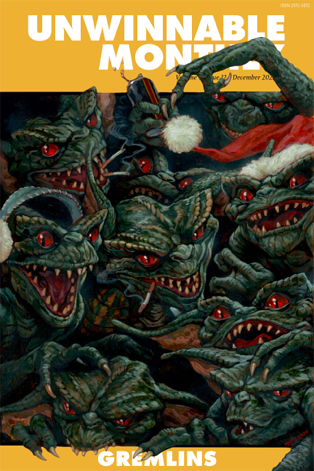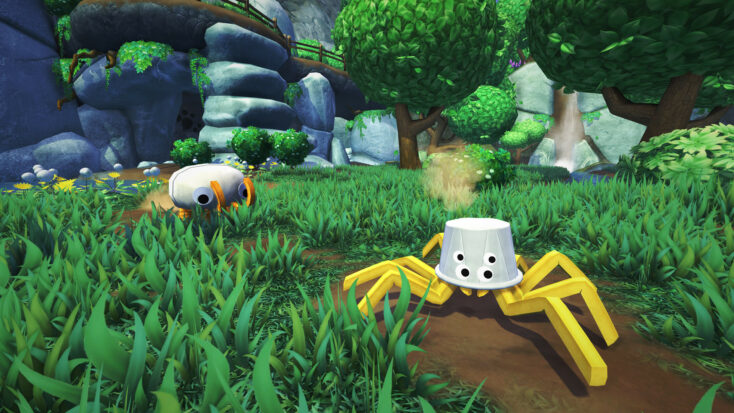
Going Gremlin Mode

This column is a reprint from Unwinnable Monthly #158. If you like what you see, grab the magazine for less than ten dollars, or subscribe and get all future magazines for half price.
———
We are what we’re afraid of.
———
(Author’s Note: Yes, I know the OED word of the year is “goblin mode,” but I humbly submit my remix as a cuter version)
A classic horror scenario; you come into contact with something that is, on its face, adorable. Maybe it’s a painting, often it’s a toy, but it’s always something that looks entirely harmless. You take it home, play with it, put in on your shelf. Cue a slow descent into nightmare fuel, as whatever it is slowly but surely reveals itself to be a manifestation of pure evil. Or just kind of mischievous, in the case of the Gremlins movie from which this issue was themed. But no matter the scale of the terror inflicted upon you by the adorable monstrosity, you know that cute things are not to be trusted.
So, since this is a column about horror and videogames, I’d like to riff a little on the theme here and expand our thinking out to when cute goes wrong more generally, and why the adorable can sometimes be the most terrifying. To start, I think we need to briefly engage in a little horror taxonomy, and then I’ll move into an example.
I assert (and others have probably argued much better before me) that horror can take two forms: the known and the unknown. The unknown is cosmic horror stuff (think Lovecraft), space and alien life (as in the Xenomorph), other things beyond our mortal ken. It’s definitely scary to be confronted by something that your brain is utterly incapable of processing, something not encompassed by the reality we understand. But what I’ve always found to be more compelling is the horror of the known. This is when an everyday object simply stops playing by the rules – haunted houses and cursed dolls are two common examples. Instead of presenting us with something entirely new, something to add to the fabric of our reality, the horror of the known rips a hole in the reality we already have. This is compelling because ultimately it means that we cannot trust that the reality we have lived in our whole lives will continue to hold up. The math, as the kids say, will stop mathing. It sows a healthy distrust in our everyday experiences, including, obviously, with adorable things like mogwai or stuffed animals.
Cuteness also has particular aesthetic value in horror because once the horror is revealed, we are not only terrified and maybe disgusted, we are affronted with how something we presumed to be innocent is actually evil. Lots of horror plays on this in different ways – babies like Rosemary’s or the now omnipresent evil clown – but it all plays into the same emotion, a fundamental “how dare you.” This adds another layer to our suspicion of everyday things (basically nobody likes clowns anymore).

To take a videogame example of this “cute horror” phenomenon, let’s think about Bugsnax for a minute. I’m sure you’ve already read editorials about how the game is actually a pretty messed up body horror parable, but a brief recap of mechanics in case you’re unaware: in the game, you capture various half-bug half-snack creatures, which you can then eat yourself or feed to your fellow adventurers. Doing so transforms the body of the adventurer into a manifestation of the snack. At first, this is presented as a goofy cosmetic mechanic, but by the end of the game, you learn the truth: that the Bugsnax are actually a hivemind parasitic life form who spread via luring people into ingesting them and then becoming addicted. Thus, what seems at first to be a family-friendly experience ends up being a kind of messed up game (though, obviously, not graphic in any traditional sense).
The specific example of Bugsnax is interesting because it points out the horror of the known in an interesting way: the horror of the game lies in something you as the player have specifically enacted upon the other characters by feeding them the Snax. It’s not only, then, the cutesy narrative that provides the vehicle for horror, but the very normal and known mechanic of making cosmetic changes to characters. Cosmetics are a part of videogaming so common now as to be taken entirely for granted in most contexts, and in most cases, we aren’t made to stop and think about what those choices mean in the context of the game-world – we are gods who can reinvent characters in our image, or whatever image we so choose. By making the cosmetic change mechanic the key to the horror of the game, Bugsnax really effectively turns cute critters with Cheetos for legs into abominations that leave the player asking, “My God, what have I done?”
So, this issue about gremlins is also kind of, a little bit, about the horror of turning the expected on its head, which is something we can also see in videogames (Bugsnax specifically, but I’ve also written elsewhere about how Slime Rancher is pretty messed up if you think about it even a little bit). The horror of the known is something that many horror games explore, and surely, eventually, more games will begin to turn to the specific horror of the cute and cuddly.
———
Emma Kostopolus is an Assistant Professor of English at Valdosta State University. Online, you can find her nowhere, but check out her film reviews for Ghouls Magazine and her recent article for Computers and Composition Online. She’s also the co-author of Ace Detective, a murder mystery dating sim you can play at oneshotjournal.com.




